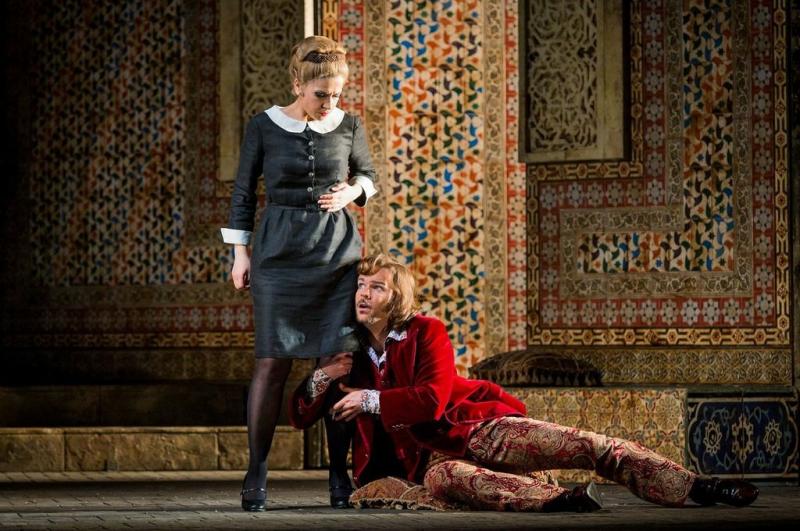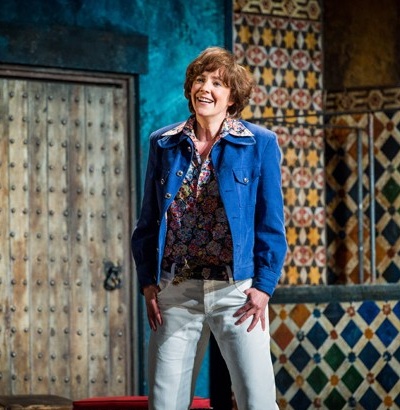Le nozze di Figaro, Glyndebourne Festival Opera | reviews, news & interviews
Le nozze di Figaro, Glyndebourne Festival Opera
Le nozze di Figaro, Glyndebourne Festival Opera
Mozart revival maintains its original style with new cast and conductor

The Marriage of Figaro is so much a part of Glyndebourne’s history that it’s sometimes hard to recall the details of this or that production.
Grandage updates to, I suppose, the swinging Seventies. The Almavivas roll on during the overture in a smart red coupé, the Count is a Richard Branson lookalike with too much hair and a range of Carnaby Street suitings, the Act 3 wedding dance is a jive-in that flickers on in the background of Act 4; we are in an egalitarian micro-climate with mere traces of ancien regime, as opposed to a social straitjacket coming apart at the seams.
 This could be ghastly but somehow isn’t, or at least only in passing. Why? Partly because the idea is internally consistent and more or less works on its own terms. Its failures are fleeting. The Count’s “Hai già vinto la causa” requires a grandeur that Joshua Hopkins is denied by the production, whether or not he has it at his own disposal. Cherubino’s passion for the Countess probably shouldn’t be consummated on her bedroom floor (Lydia Teuscher as Cherubino, pictured above).
This could be ghastly but somehow isn’t, or at least only in passing. Why? Partly because the idea is internally consistent and more or less works on its own terms. Its failures are fleeting. The Count’s “Hai già vinto la causa” requires a grandeur that Joshua Hopkins is denied by the production, whether or not he has it at his own disposal. Cherubino’s passion for the Countess probably shouldn’t be consummated on her bedroom floor (Lydia Teuscher as Cherubino, pictured above).
But the successes are more important. They start with the stage direction: sharp observation and crisp management from first scene to last. Some credit for this should go to the revival director, Ian Rutherford. This is a genuinely comic Figaro, but also a very touching one, and not only in the dénouement. Figaro’s garden duet with the disguised Susanna has a truth and precision, superbly conveyed by Adam Plachetka and Laura Tatulescu (pictured below), despite the absurdity of the situation (less than usual, though: Tatulescu’s disguise is almost too convincing); but even the recognition scene in Act 3, which is ludicrous even by the usual standards of opera buffa, touches some sentimental chord remote from the farcical deus ex machina spoof.
Of course none of this would cut much ice without singing and acting of the quality we now happily take for granted at Glyndebourne. The cast, entirely new from last year (with one significant switch), has no serious weakness and is rich in talent fresh to these shores – an extraordinary tribute to the company’s talent-spotting flair. Tatulescu’s Susanna is outstanding, witty, personable, agile-voiced but able to flood with warmth at the right moment, which “Deh vieni” certainly is, even though its passion – so typically of Mozart – is spurious, fed by anger.
 The production’s original Susanna, Lydia Teuscher, is now Cherubino, a role often taken by mezzos, but here sparkling in the hands of a genuine soprano who can throw off a tremulous, high-speed “Non so più” as if it were the easiest thing in the world. His/her tendency to melt at every mention of the Countess is admittedly understandable when the lady in question is the willowy Amanda Majeski, irresistible even when briefly tested by her Act 2 coloratura, superb in “Porgi amor” and, especially, “Dove sono.”
The production’s original Susanna, Lydia Teuscher, is now Cherubino, a role often taken by mezzos, but here sparkling in the hands of a genuine soprano who can throw off a tremulous, high-speed “Non so più” as if it were the easiest thing in the world. His/her tendency to melt at every mention of the Countess is admittedly understandable when the lady in question is the willowy Amanda Majeski, irresistible even when briefly tested by her Act 2 coloratura, superb in “Porgi amor” and, especially, “Dove sono.”
Perhaps the males are less utterly ideal. But the qualification is mild. I like Plachetka’s Figaro, floppy black hair and all, though his character loses some of its edge for lack of a worthy adversary in Hopkins’s Count – the fault, as already indicated, of the production. Hopkins actually sings stylishly and got an ovation (a shade unexpectedly) for his aria. Luciano Di Pasquale is a tubby, likeable Bartolo – no mean feat (the likeability, that is), Timothy Robinson a smarmy schoolmaster Basilio, Anne Mason a sharp-tongued Marcellina sadly deprived of her final-act aria. Basilio loses his as well, but that we can survive. Sara Lian Owen, from the Glyndebourne chorus, is a sweet, cheeky Barbarina, who makes the most of her tiny, soulful song about the lost pin.
The conductor Jérémie Rhorer, a period specialist confronted by the modern London Philharmonic Orchestra, comes through with flying colours, often at tempi that some will find on the quick side, now and then punctuating Mozart with unexpected rubatos and fermatas, but always alert to his singers’ needs, and with a sure hand on the orchestra. Gareth Hancock supplies immaculate, stylish keyboard continuo.
rating
Share this article
Add comment
The future of Arts Journalism
You can stop theartsdesk.com closing!
We urgently need financing to survive. Our fundraising drive has thus far raised £49,000 but we need to reach £100,000 or we will be forced to close. Please contribute here: https://gofund.me/c3f6033d
And if you can forward this information to anyone who might assist, we’d be grateful.

Subscribe to theartsdesk.com
Thank you for continuing to read our work on theartsdesk.com. For unlimited access to every article in its entirety, including our archive of more than 15,000 pieces, we're asking for £5 per month or £40 per year. We feel it's a very good deal, and hope you do too.
To take a subscription now simply click here.
And if you're looking for that extra gift for a friend or family member, why not treat them to a theartsdesk.com gift subscription?
more Opera
 Albert Herring, English National Opera review - a great comedy with depths fully realised
Britten’s delight was never made for the Coliseum, but it works on its first outing there
Albert Herring, English National Opera review - a great comedy with depths fully realised
Britten’s delight was never made for the Coliseum, but it works on its first outing there
 Carmen, English National Opera review - not quite dangerous
Hopes for Niamh O’Sullivan only partly fulfilled, though much good singing throughout
Carmen, English National Opera review - not quite dangerous
Hopes for Niamh O’Sullivan only partly fulfilled, though much good singing throughout
 Giustino, Linbury Theatre review - a stylish account of a slight opera
Gods, mortals and monsters do battle in Handel's charming drama
Giustino, Linbury Theatre review - a stylish account of a slight opera
Gods, mortals and monsters do battle in Handel's charming drama
 Susanna, Opera North review - hybrid staging of a Handel oratorio
Dance and signing complement outstanding singing in a story of virtue rewarded
Susanna, Opera North review - hybrid staging of a Handel oratorio
Dance and signing complement outstanding singing in a story of virtue rewarded
 Ariodante, Opéra Garnier, Paris review - a blast of Baroque beauty
A near-perfect night at the opera
Ariodante, Opéra Garnier, Paris review - a blast of Baroque beauty
A near-perfect night at the opera
 Cinderella/La Cenerentola, English National Opera review - the truth behind the tinsel
Appealing performances cut through hyperactive stagecraft
Cinderella/La Cenerentola, English National Opera review - the truth behind the tinsel
Appealing performances cut through hyperactive stagecraft
 Tosca, Royal Opera review - Ailyn Pérez steps in as the most vivid of divas
Jakub Hrůša’s multicoloured Puccini last night found a soprano to match
Tosca, Royal Opera review - Ailyn Pérez steps in as the most vivid of divas
Jakub Hrůša’s multicoloured Puccini last night found a soprano to match
 Tosca, Welsh National Opera review - a great company reduced to brilliance
The old warhorse made special by the basics
Tosca, Welsh National Opera review - a great company reduced to brilliance
The old warhorse made special by the basics
 BBC Proms: The Marriage of Figaro, Glyndebourne Festival review - merriment and menace
Strong Proms transfer for a robust and affecting show
BBC Proms: The Marriage of Figaro, Glyndebourne Festival review - merriment and menace
Strong Proms transfer for a robust and affecting show
 BBC Proms: Suor Angelica, LSO, Pappano review - earthly passion, heavenly grief
A Sister to remember blesses Puccini's convent tragedy
BBC Proms: Suor Angelica, LSO, Pappano review - earthly passion, heavenly grief
A Sister to remember blesses Puccini's convent tragedy
 Orpheus and Eurydice, Opera Queensland/SCO, Edinburgh International Festival 2025 review - dazzling, but distracting
Eye-popping acrobatics don’t always assist in Gluck’s quest for operatic truth
Orpheus and Eurydice, Opera Queensland/SCO, Edinburgh International Festival 2025 review - dazzling, but distracting
Eye-popping acrobatics don’t always assist in Gluck’s quest for operatic truth
 MARS, Irish National Opera review - silly space oddity with fun stretches
Cast, orchestra and production give Jennifer Walshe’s bold collage their all
MARS, Irish National Opera review - silly space oddity with fun stretches
Cast, orchestra and production give Jennifer Walshe’s bold collage their all

Comments
Regardless of any slight